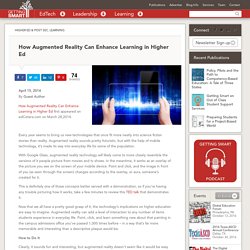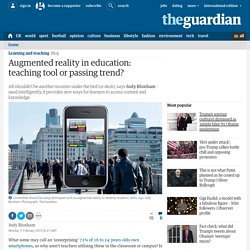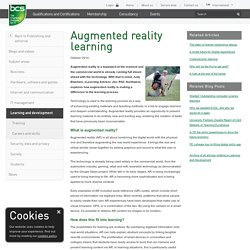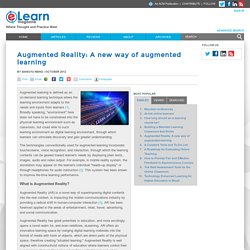

Augmented reality and workplace training. It’s still early on in the story of augmented reality, but already it’s starting to make an impact in some aspects of the workplace.

As the technology matures, its role as a potential training tool is becoming just a little clearer, and the possibilities are exciting. Augmented reality (AR) brings together the real and the digital world, allowing computer-generated images, information and data to be superimposed over what you can see around you. The earliest form of technology dates back more than 50 years, but the term augmented reality is believed to have been coined in 1990 by Professor Tom Caudell, then a researcher with Boeing. The initial excitement over AR was very much centred on its personal use with consumer devices such as Google Glass getting a lot of early attention, although not quite breaking through as first predicted.
Enhancing Student Learning with Augmented Reality. Augmented Reality: The future and development of AR Technology. How Augmented Reality Can Enhance Learning in Higher Ed - Getting Smart by EdCetera Staff - 21stedchat, augmented reality, EdTech, Highered. How Augmented Reality Can Enhance Learning in Higher Ed first appeared on edCetera.com on March 28,2014.

Every year seems to bring us new technologies that once fit more neatly into science fiction stories than reality. Augmented reality sounds pretty futuristic, but with the help of mobile technology, it’s made its way into everyday life for some of the population. With Google Glass, augmented reality technology will likely come to more closely resemble the versions of it people picture from movies and tv shows. In the meantime, it works as an overlay of the picture you see on the screen of your mobile device. Point and click, and the image in front of you (as seen through the screen) changes according to the overlay, or aura, someone’s created for it. This is definitely one of those concepts better served with a demonstration, so if you’re having any trouble picturing how it works, take a few minutes to review this TED talk that demonstrates it.
How to Do It Possible Uses. Ar edu. Augmented reality in education: teaching tool or passing trend? What some may call an 'unsurprising' 71% of 16 to 24-years-olds own smartphones, so why aren't teachers utilising these in the classroom or campus?

Is the use of these devices going to detract from the learning process or contribute to future workplace skills? Should teachers be using techniques such as augmented reality (AR) to engage students and develop their skills for the modern world? Well, I say 'yes'. I believe we should be embracing these opportunities. For instance I see AR as a real opportunity for colleges and universities, not only as a way to market and promote themselves, but as a way to communicate with learners and improve the student experience. AR allows people to add digital content to printed material, geographic locations and objects. City University London have used a combination of techniques to develop resources through the CARE (Creating Augmented Reality in Education) project for healthcare students, including a series of 'health walks'.
AugThat - Augmented Reality Learning Media, Augmented Reality Learning in classroom education. Augmented reality learning. October 2014 Augmented reality is a buzzword at the moment and the commercial world is already running full steam ahead with the technology.

With that in mind, Judy Bloxham, eLearning Advisor, Jisc RSC Northwest, explores how augmented reality is making a difference to the learning process. Technology is used in the learning process as a way of enhancing existing materials and teaching methods, in a bid to engage learners and deepen understanding. Rev183ART10en. Learning and Collaboration Technologies: Second International Conference ...
How can we improve learning and education through Augmented Reality? - Quora. The Augmented Future Of eLearning: Augmented Reality In eLearning - eLearning Industry. In this article, you are going to witness the first iteration of a new type of head mounted display that is going to change the way we see the world.

It will fundamentally change the way in which we learn about new subjects, and how we apply that knowledge in our everyday lives. The Microsoft HoloLens is the first product of its kind to change the environment around you. This technology is about to radically change the way in which you learn, and will hopefully revolutionize your perspective in regards to how you examine the world. Augmented Reality: A new way of augmented learning. Augmented learning is defined as an on-demand learning technique where the learning environment adapts to the needs and inputs from learners [1].

Broadly speaking, "environment" here does not have to be constrained into the physical learning environment such as classroom, but could refer to such learning environment as digital learning environment, through which learners can stimulate discovery and gain greater understanding. The technologies conventionally used for augmented learning incorporate touchscreens, voice recognition, and interaction, through which the learning contents can be geared toward learner's needs by displaying plain texts, images, audio and video output. For example, in mobile reality system, the annotation may appear on the learner's individual "heads-up display" or through headphones for audio instruction [2].
This system has been shown to improve life-time learning performance. Augmented-Reality-Teaching-Learning.